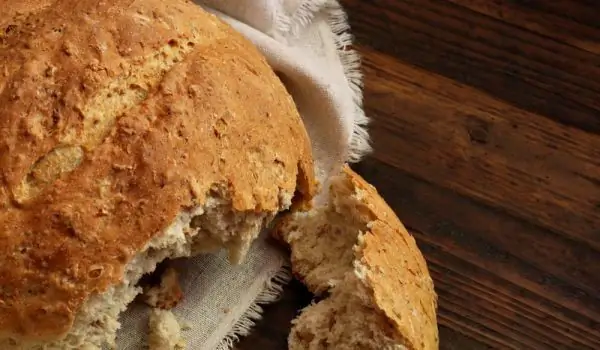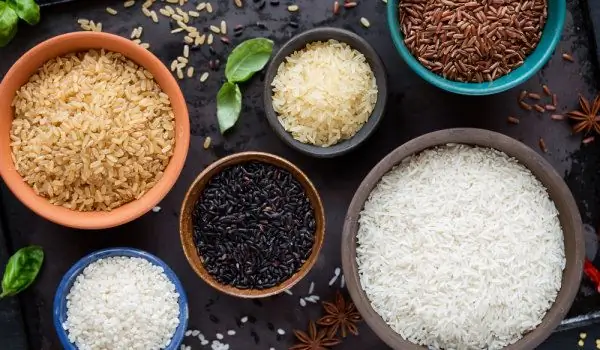2025 Author: Jasmine Walkman | [email protected]. Last modified: 2025-01-23 10:18
Wholemeal bread is one of the most valuable foods for humans, as long as it is made from quality raw materials and is not accompanied by unwanted ingredients such as enhancers, stabilizers and preservatives. By its nature, wholemeal is the bread for which flour with all parts of the grain is used. It is a source of valuable nutrients in the diet of modern man.
There are statistics that the consumption of healthy types of bread, including wholemeal, is among the most dynamically developing niches on the market. These subsistence species occupy over 20% of the consumption in our country, while 5 years ago the percentage was only 5-6%.
The strength of wholemeal bread lies in the fact that it is made by grinding the whole grain, which hides all the natural fiber, vitamins, minerals and nutrients important to the body and giving it the necessary energy.

There are different types whole grain bread, but a unifying factor in all is that they are prepared from whole grains. Some of the products on the market are a mixture of a higher percentage of wholemeal flour and a lower percentage of white flour. However, only 100% whole grain bread guarantees everything useful in whole grains. Among the products labeled "whole grain" you will find - wheat whole grain, rye whole grain and multigrain whole grain, with the addition of various types of seeds (flax, poppy, sesame, oats, etc.), vitamins and fiber.
Wholemeal bread differs from the others in its way of production. As a rule, crushed wheat grains, called wheat meal, should be added to it, thus ensuring the preservation of all components of the grain in a balanced natural combination. Usually this type of bread undergoes less processing, which brings them as close as possible to a completely natural product.
In Germany, bread is even produced with the addition of a minimum amount of yeast, which is left to sour on its own for a few days at a temperature of 25 degrees without direct contact with the air and only then baked. This gives the bread prepared in this way a pleasant and slightly sour taste.
In general, wholemeal bread has a specific pleasant taste and aroma, a denser texture than white and has a slightly moist environment. Quality wholemeal bread should be made from flour type 1850. This type of flour and the product produced with it have a lower glycemic index, which is beneficial for diabetics and those who want to lose weight. Wholemeal bread is considered a dietary product.
Composition of wholemeal bread

In 100 g whole grain bread contains an average of 54.6 g of carbohydrates, 7.8 g of protein, 0.2 g of fat, various vitamins and about 100 to 250 kcal for different species. In company production of whole grain bread usually mentioned already mentioned wheat meal, sesame, poppy, flax, sunflower seeds, oats, soybeans - 10%, sour rye yeast, malt extract, pressed yeast, iodized salt and various enhancers (enzymes; antioxidants - ascorbic acid (vitamin C), emulsifier - sodium sterol lactate, calcium propionate) and others.
An important carbohydrate ingredient in whole grains is fiber (cellulose, hemicellulose, pectins, lignins, etc.). For the most part, they are indigestible by the body, but have a regulatory effect on the functioning of the intestine.
Lack of fiber in the body predisposes him to an increased risk of obesity, chronic constipation, hemorrhoids, colon cancer, intestinal diverticula. The proteins in wholemeal bread balance the amino acid composition, or in other words, the quality of the total protein intake.
Selection and storage of wholemeal bread
When choosing whole grain bread in the store the first and basic rule is to observe the content - what is the percentage of flour from grinding whole grains, is there any other flour added and what are the improvers in it. The next criteria is related to the texture of the bread - experts are adamant that the real whole grain bread does not spring under pressure. The bread, in which dyes are used, resembles foam in texture.

An easy and clever way to check the quality of the bread you buy is to put a slice of it in a glass of water. If the bread contains coffee, caramel or other coloring residue, the water will color. The quality whole grain bread does not color the water.
Usually the shelf life of the bread is indicated on the package, but it often happens that after the expiration date, the bread does not spoil. This is also a sign that it has different preservatives. You can keep the maximum durability of the bread in the refrigerator, and it must be packed in an envelope.
Benefits of wholemeal bread
Wholemeal bread is a useful food for people with diabetes. With regular consumption of quality wholemeal bread, weight loss, reduction of blood sugar levels, glycated hemoglobin, triglycerides and other indicators are observed.

Whole grains have the ability to favorably affect constipation, as well as excess cholesterol, excreting it in the feces. For children after 3 years of age it is recommended to start consuming with whole grain bread, nutritionists explain. As a complete food, real and natural wholemeal bread has a beneficial effect on the heart, maintains a healthy weight, improves digestion and gives more tone and energy. All this in a heap is a prerequisite for our better mood and self-confidence.
Harm from whole grain bread
Although useful for the most part, wholemeal bread, especially if of poor quality, can be risky for people with high blood sugar and insulin sensitivity. That's why diabetics should be careful not to trust any product labeled "whole grain." On the other hand, there is the issue of fiber, because a certain amount of fiber is good for the body and peristalsis, but more fiber can remove valuable minerals from the body.
Recommended:
Here's How To Make Healthy Live Bread (Rustic Sourdough Bread)

Bulgarians are one of the people who consume the most bread . Today it is difficult to find quality and tasty bread. The stores offer different types of pasta - wholemeal, multigrain, river bread, black, type, einkorn, vegetables, etc. In the factories where the bread is made, all kinds of improvers, preservatives, leavening agents and colorants are used.
Round Grain Rice - What We Need To Know

The rice occupies a leading position among various cereals in the world. Today, there are about 1,500 different varieties of this product, and not just for no reason it is very popular and consumed. Rice is also very nutritious - it is rich in cellulose, vitamins, minerals and various nutrients that are extremely good for health.
Medium Grain Rice - What We Need To Know

Many do not know the difference between different types of rice according to the type of grain. Here we will introduce you features of medium-grain rice . It has some invaluable advantages that make it indispensable for the preparation of some culinary temptations.
The Difference Between Long Grain, Short Grain And Medium Grain Rice

The rice is one of the most useful cereals. It is rich in complex carbohydrates (75% - 85%) and protein (5% - 10%), which are the main source of energy for the body. That is why it is so widely used. However, its preparation proves to be a difficult task for many.
Outrageous! Bulgarian Bread Is Not Made From Grain, But From Blanks

Bulgarian bread is a mixture of frozen blanks, although our grain industry is a leader in our agriculture. Most of the grain goes for export, announced Assoc. Prof. Dr. Ognyan Boyukliev from the Institute for Economic Research at the Bulgarian Academy of Sciences.

